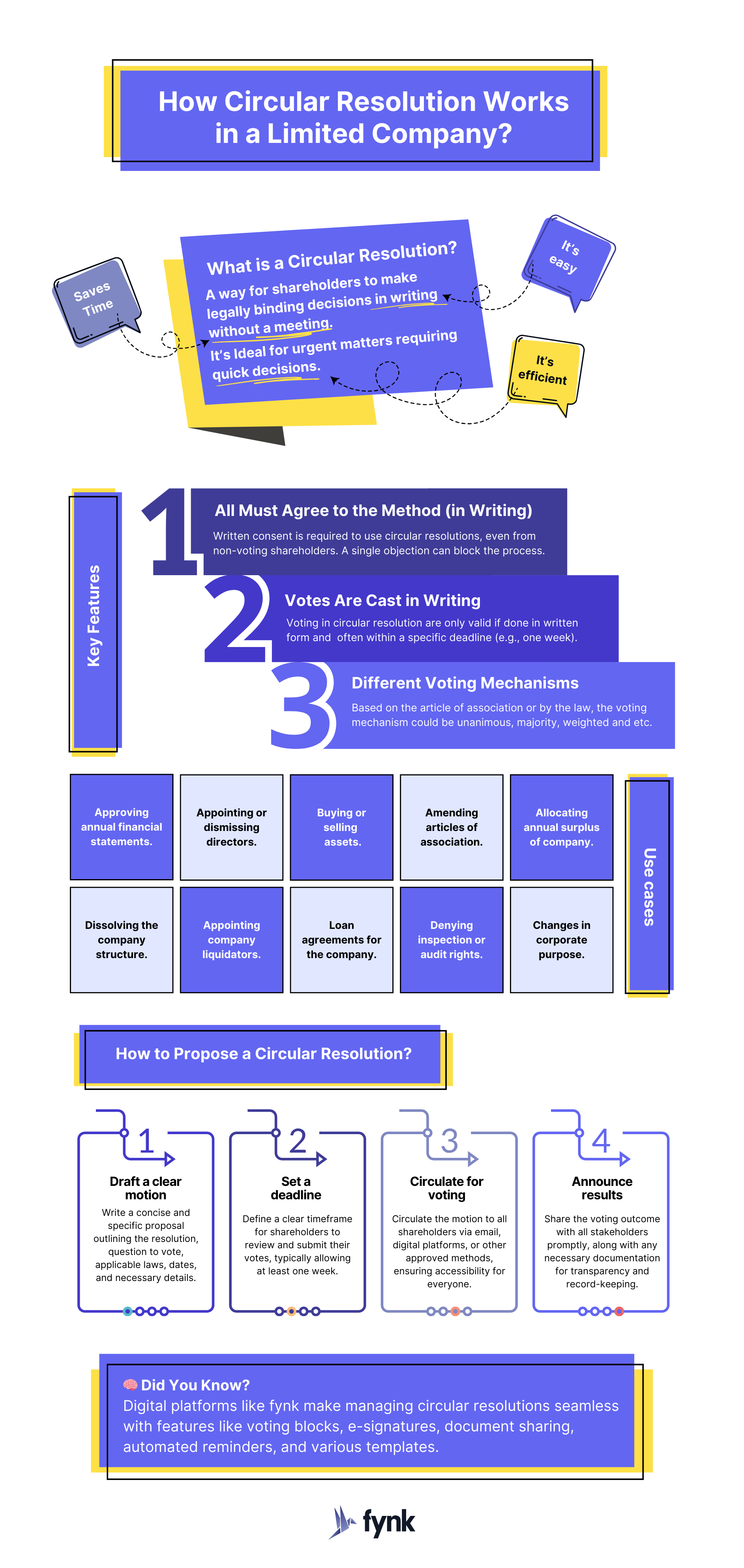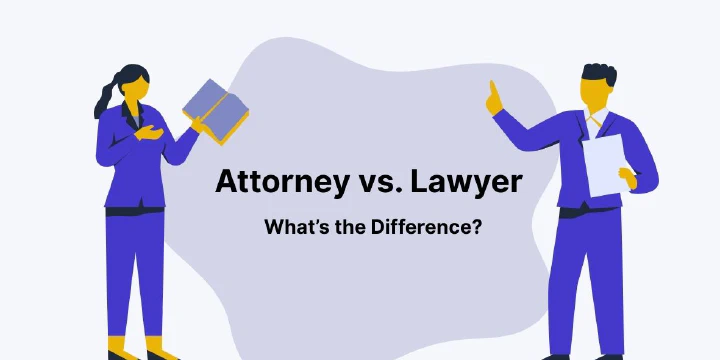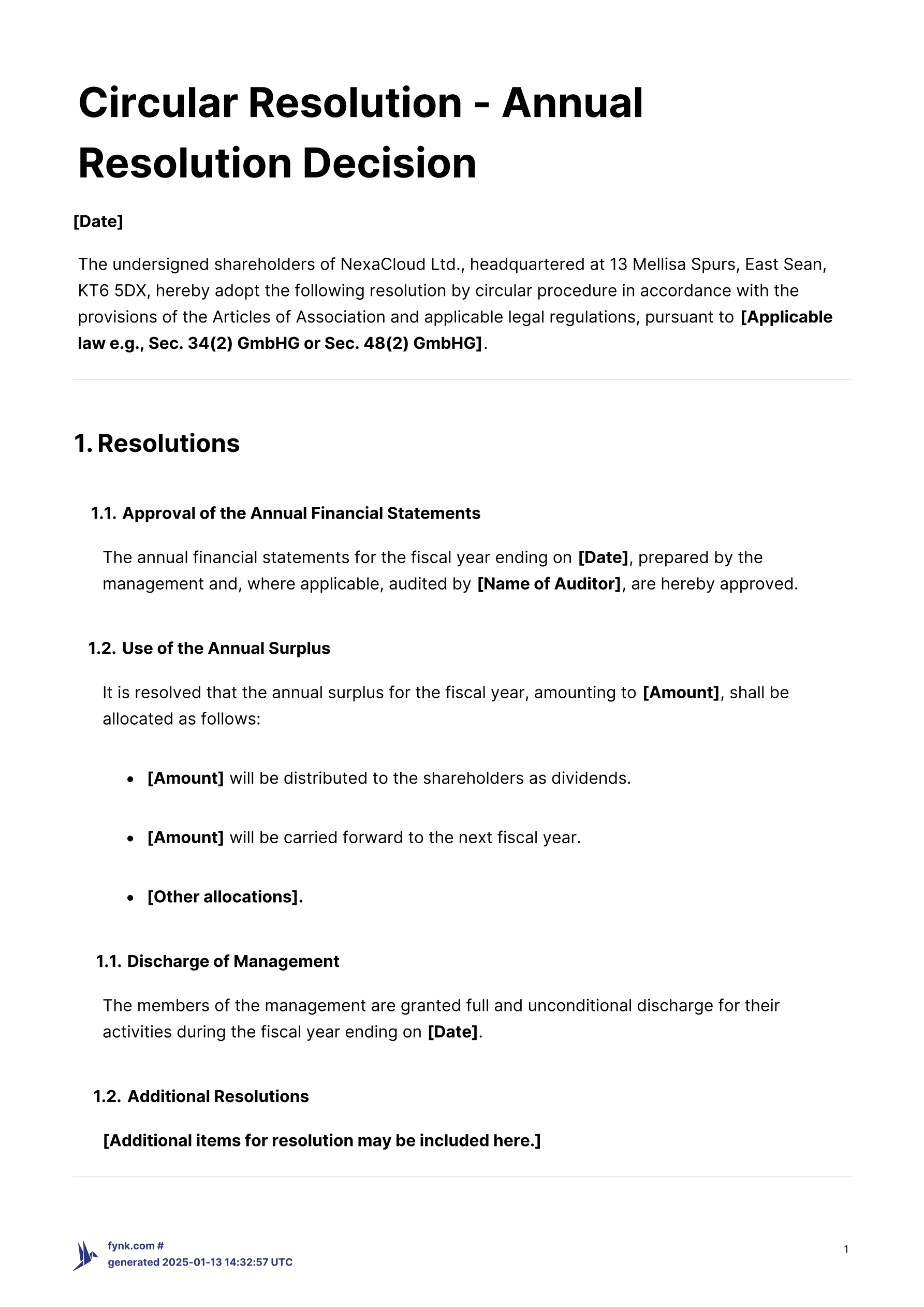Guide to Circular Resolutions for Ltd. Shareholders + Templates
Shareholders are involved in decisions such as approving financial statements, electing or re-electing directors, and making significant corporate changes during the company’s general meetings. However, there are times when stakeholders need to reach such resolutions immediately, avoiding the hassle of organizing a general meeting. In such cases, a circular resolution offers a shortcut, allowing stakeholders to vote on and pass resolutions remotely and in writing without needing a formal meeting. In this guide, we’ll break down the what, why, and how of circular resolutions, provide practical tips, and offer handy templates to make your life easier. Let’s get started!
- What is Circular Resolution?
- Benefits of Circular Resolutions
- When Companies Use a Circular Resolution?
- Circular resolution for the approval of the annual financial statements
- Resolution on the appropriation of annual surplus
- Circular resolution for the appointment or dismissal of managing directors
- Circular resolution for the conclusion of a contract
- Circular resolution for the dissolution of a Ltd.
- Circular resolution for the appointment of liquidators
- Circular resolution for the denial of information or inspection rights
- Circular resolution for the rectification of deficiencies in the corporate purpose
- Circular resolution for the company’s borrowing of funds
- Circular resolution for the disposal of assets
- Circular resolution for the acquisition of assets
- Who Can Start a Circular Resolution?
- How Many Resolutions Can You Reach in One Circular Resolution?
- How to Propose a Circular Resolution?
- Digital Circular Resolutions with fynk + Templates
- FAQs

What is Circular Resolution?
A circular resolution is a decision-making process that allows shareholders to reach legally binding resolutions in writing, without the need to attend a general meeting in person. Widely accepted in Germany and Austria, circular resolutions can be used to vote on various shareholder matters, such as approving annual financial statements, purchasing assets, or making decisions on special contracts. Examples include approval of annual financial statements, purchase of assets, and decisions on special contracts.
§ 34 GmbHG in Austria and § 48 GmbHG in Germany outline the rules for circular resolutions and provide guidelines on their proper implementation. According to both regulations, there are three key considerations when using circular resolutions:
1. Unanimous Agreement on Using a Circular Resolution: Before a resolution can be passed through a circular resolution, all shareholders, including those without voting rights, must unanimously agree to use this method. Crucially, this agreement must be provided in writing. It’s important to note that this unanimous consent applies solely to the use of the circular resolution procedure and not to the content of the resolution itself.
❗Important: Even if all shareholders initially agree to use a circular resolution, the process can be halted if even one shareholder later refuses to provide the written consent required. In such cases, a majority vote is not possible.
2. Written Votes Within a Specific Timeframe: Voting members must cast their votes in writing, typically within a designated timeframe (often one week). Only shareholders with voting rights are eligible to participate in the voting process.
3. Varying Voting Mechanisms: The voting mechanism can vary depending on the matter being decided. In some cases, the company’s articles of association, along with applicable laws, determine the voting requirements. For example, under German GmbHG, unanimous shareholder approval is required to amend the articles of association or rectify any defects through shareholder resolutions.
Here are some of the common voting mechanisms used in a company:
3.1. Unanimous voting: A decision is approved only if all eligible voters are in complete agreement—100% of participants must vote in favor of the resolution or decision to pass. Even one dissenting vote or abstention can block the decision. This method is typically used for resolutions of high importance. In the case of unanimous voting through a circular resolution, only voting shareholders have the right to participate.
3.2. Majority Voting: A decision is approved if it receives more than half (50% + 1) of the votes cast.
3.3. Supermajority Voting: Supermajority Voting: A higher threshold than a simple majority, often requiring 66.7% (two-thirds) or 75% of the votes.
3.4. Weighted Voting: Votes are weighted based on specific criteria, such as the number of shares held by a shareholder. Often used in corporate contexts where voting power is proportional to ownership. For example, a shareholder owning 60% of a company’s shares has 60% of the voting power.
🧠 Did you Know? According to GmbHG in Austria, for written votes, the required majority is calculated based on the total number of votes to which all shareholders are entitled, not just the votes cast.



Benefits of Circular Resolutions
Saving Time: Circular resolutions save valuable time and reduce costs by eliminating the need for shareholders to attend meetings in person. Additionally, voting doesn’t have to happen simultaneously; shareholders can submit their votes by a set deadline.
Flexible Voting Methods: The rules for circular resolutions only require that votes be submitted in writing. This flexibility means voting can be done electronically via email, text message, WhatsApp, or a platform like fynk, which allows users to vote and sign documents electronically.
Quicker Decision-making: Circular resolutions often include a deadline for the voting process. Since voting is done remotely, there’s minimal need for in-person negotiations, enabling quicker resolution of matters.



When Companies Use a Circular Resolution?
A circular resolution can serve as an alternative to an ordinary shareholder resolution in general meetings. Its usage largely depends on the company’s articles of association and applicable laws. However, circular resolutions are particularly useful for addressing matters that need to be resolved quickly and efficiently, without unnecessary delays.
Here are some of the most common shareholder resolutions that can be passed using the circular resolution method:
Circular resolution for the approval of the annual financial statements
Resolution on the appropriation of annual surplus
Circular resolution for the appointment or dismissal of managing directors
Circular resolution for the conclusion of a contract
Circular resolution for the dissolution of a Ltd.
Circular resolution for the appointment of liquidators
Circular resolution for the denial of information or inspection rights
Circular resolution for the rectification of deficiencies in the corporate purpose
Circular resolution for the company’s borrowing of funds
Circular resolution for the disposal of assets
Circular resolution for the acquisition of assets
Who Can Start a Circular Resolution?
Only shareholders or their representatives can propose a shareholder resolution using the circular resolution method, even if they have voting limits on certain topics. However, other individuals may suggest a circular resolution if authorized by the company’s articles of association. For example, a managing director could propose a motion for a shareholder resolution using this method if permitted under the company’s governing rules.
As mentioned earlier, a circular resolution can only be used if:
- The articles of association explicitly allow resolutions to be passed in written form.
- All shareholders, including those without voting rights, agree to resolutions being made outside of a formal shareholders’ meeting.
How Many Resolutions Can You Reach in One Circular Resolution?
You can include multiple shareholder resolutions in a single circular resolution round as long as the following criteria are met:
- The topics are closely related: For example, decisions about financial approvals, project funding, or director appointments that logically connect can be grouped together.
- Clarity and distinction: Each resolution must be clearly defined, easily distinguishable, and free from any ambiguity.
How to Propose a Circular Resolution?
Step 1: Write a Motion (Proposal)
Circular resolution motions are typically short, straightforward, one-page documents written in clear and direct language. Before drafting the motion, consult the company’s articles of association and bylaws to identify any limitations, special conditions, or procedures regarding resolutions made outside of formal meetings. For example, some articles of association may require certain types of resolutions to be passed exclusively in general meetings.
Here’s a step-by-step guide to writing a proposal for a circular resolution:
1. Start with an introductory section
Begin by including the company’s name, address, and the date at the top of the page. Provide a brief introduction to the matter and reference the applicable laws or regulations. For example: “Pursuant to [Article X of the Articles of Association] of [Company XY] and § 48 GmbHG, the following resolution is proposed for adoption via a circular resolution.”
2. Write the resolution text
Use clear and concise language to describe the action being approved. Start with “It is hereby resolved that:” followed by the decision. The proposal should be a straightforward statement, allowing shareholders to express their votes with a simple “yes” or “no.”
Examples of Good and Bad Motions:
✅ Good example:
“It is hereby resolved that the purchase of 100 units of office chairs from Supplier XYZ for a total amount of $5,000 is approved. [Name], [Title], is authorized to sign the purchase agreement on behalf of [Company Name].”
❌ Bad example:
“It is hereby resolved that the necessary purchase for the office is approved. [Name], [Title], is authorized to proceed with the agreement.”
3. Include voting and signing blocks
Add clear voting options, along with spaces for shareholders’ names, their share amounts, signatures, and dates.
Example:
“Approved Not Approved
Name: ____________________________ Signature: _______________________ Date: ____________________________”
🧠 Did you know? With the fynk contract management platform, you can manage circular resolutions digitally—no need to pass the document to each party individually or collect votes one by one!
Searching for a contract management solution?
Find out how fynk can help you close deals faster and simplify your eSigning process – request a demo to see it in action.
Step 2: Set a Deadline
Establish a deadline for the voting process. Typically, this is set to at least one week after the process is initiated. A clear deadline ensures the resolution doesn’t become invalid due to delays, misunderstandings, or disputes over the circulation process. To prevent such issues, it’s recommended to include a deadline either in the shareholder agreement or within the resolution itself, specifying that the resolution will only be valid if signed and returned by a certain date. This adds clarity, avoids prolonged disputes, and preserves legal validity.
Step 3: Send the Motion to Shareholders
Once the motion is finalized, distribute it to the shareholders. There are two common methods for this:
Sequential Voting: Pass the resolution from one shareholder to the next for voting and signing.
Simultaneous Voting: Collect votes from all shareholders at the same time—this is generally the more convenient option.
Step 4: Announce the Result and Store the Documents
After the voting process concludes, share the final results with all shareholders and provide each with a receipt copy. Make sure to securely store the resolution documents in a centralized repository for future reference.
Digital Circular Resolutions with fynk + Templates
Circular resolutions are a great way to save time, and the process becomes even faster when handled digitally. While email and text messaging may seem simple, managing replies and keeping track of votes can quickly become overwhelming. A dedicated document management platform like fynk simplifies this process with features such as:
- Access restrictions for sensitive resolutions.
- Integrated vote and signature blocks for streamlined execution.
- Activity logs to track access and actions.
- Deadline settings to finalize resolutions on time.
- Automatic notifications and reminders for pending votes.
- Secure sharing of documents with shareholders.
- Customizable templates for various resolution types.
- A centralized repository for secure storage of resolutions.
- Qualified Electronic Signatures (QES) for enhanced security and legal compliance.
With fynk, you can draft resolutions from scratch or use pre-designed templates. Shareholders can digitally vote and sign, and you’ll receive notifications for every submission. This not only accelerates the process but also ensures compliance, security, and efficient record-keeping.
FAQs
- What Happens if Someone Does Not Cast a Vote?
- If someone does not cast a vote, it typically means they abstain from the decision. Depending on the company’s rules or the resolution’s specifics, this may either count as a non-approval or be ignored in the final tally.
- Are Circular Resolutions Legally Binding?
- Yes, circular resolutions are legally binding as long as they follow the proper procedures outlined in the company’s bylaws and applicable laws. They carry the same weight as resolutions passed at a formal meeting.
- Can a Circular Resolution Be Amended Once Sent Out?
- Yes, a circular resolution can be amended, but this typically requires the consent of all parties involved. If amendments are made after the document is circulated, the updated resolution should be re-sent for signatures.
- What Happens if the Deadline for Voting is Missed?
- If the voting deadline is missed, the resolution may be considered invalid unless all shareholders agree to extend the deadline. It’s crucial to set a clear deadline to avoid this situation.
- Can Circular Resolutions Be Used for Any Type of Decision?
- No, circular resolutions are typically limited to matters that can be resolved without the need for a meeting, such as routine decisions or urgent matters that require quick approval. Some company bylaws may restrict their use.
- Can Electronic Signatures Be Used for Circular Resolutions?
- Yes, electronic signatures are generally acceptable for circular resolutions, provided they comply with applicable laws and the company’s internal policies or bylaws.
Please keep in mind that none of the content on our blog should be considered legal advice. We understand the complexities and nuances of legal matters, and as much as we strive to ensure our information is accurate and useful, it cannot replace the personalized advice of a qualified legal professional.

Table of contents
- What is Circular Resolution?
- Benefits of Circular Resolutions
- When Companies Use a Circular Resolution?
- Circular resolution for the approval of the annual financial statements
- Resolution on the appropriation of annual surplus
- Circular resolution for the appointment or dismissal of managing directors
- Circular resolution for the conclusion of a contract
- Circular resolution for the dissolution of a Ltd.
- Circular resolution for the appointment of liquidators
- Circular resolution for the denial of information or inspection rights
- Circular resolution for the rectification of deficiencies in the corporate purpose
- Circular resolution for the company’s borrowing of funds
- Circular resolution for the disposal of assets
- Circular resolution for the acquisition of assets
- Who Can Start a Circular Resolution?
- How Many Resolutions Can You Reach in One Circular Resolution?
- How to Propose a Circular Resolution?
- Digital Circular Resolutions with fynk + Templates
- FAQs
Want product news and updates? Sign up for our newsletter.
Other posts in Business

40 Must-Know Contract Management Trends for 2025
The data is clear, Contract management is undergoing a major transformation, with businesses shifting away …

Guide to Circular Resolutions for Ltd. Shareholders + Templates
Shareholders are involved in decisions such as approving financial statements, electing or re-electing …

Contract Renewal vs. Contract Extension
Explore the distinctions between contract renewal and extension, including their advantages and drawbacks, …
Other posts in Law

What’s the Difference Between a Lawyer and an Attorney
Attorneys and lawyers are not the same: all attorneys are lawyers, but not all lawyers are attorneys. In the …

Guide to Circular Resolutions for Ltd. Shareholders + Templates
Shareholders are involved in decisions such as approving financial statements, electing or re-electing …

Understanding Breach of Contract: Consequences and Prevention
Discover the different forms a contract breach can take, the legal and financial consequences that result, and …
Contracts can be enjoyable. Get started with fynk today.
Companies using fynk's contract management software get work done faster than ever before. Ready to give valuable time back to your team?
Schedule demo












